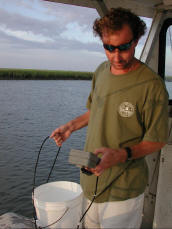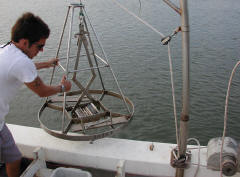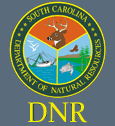Methods
Sampling Design:
 From 1999 - 2004, 60 stations were randomly selected for sampling each year. During 2005-2006, a total of 50 stations were sampled each year and current sampling efforts have been reduced to 30 stations per year. All sites are located within the coastal zone extending from the saltwater - freshwater interface to near the mouth of each estuarine drainage basin and extending from the Little River Inlet at the North Carolina border to the Wright River near the Georgia border. The Savannah River is not included in the SCECAP initiative, but is being sampled by the Georgia Coastal Resources Division as part of the USEPA National Coastal Assessment Program.
From 1999 - 2004, 60 stations were randomly selected for sampling each year. During 2005-2006, a total of 50 stations were sampled each year and current sampling efforts have been reduced to 30 stations per year. All sites are located within the coastal zone extending from the saltwater - freshwater interface to near the mouth of each estuarine drainage basin and extending from the Little River Inlet at the North Carolina border to the Wright River near the Georgia border. The Savannah River is not included in the SCECAP initiative, but is being sampled by the Georgia Coastal Resources Division as part of the USEPA National Coastal Assessment Program.
About half of the stations are located in tidal creeks and the other half are located in the larger open water bodies that form South Carolina's tidal rivers, bays and sounds. For the purposes of this program, tidal creeks are defined as those estuarine water bodies less than 100m (328 ft) in width from marsh bank to marsh bank, with stations limited to the portion of creeks having at least 1m of water depth at low tide. Using these criteria, approximately 17% of the state's estuarine waters represent creek habitat, with the remaining 83% representing larger open water bodies.
All stations are sampled once during the summer months (mid June through August) for the core monitoring program described in the SCECAP 1999-2000 report. The summer period was selected because it represents a period when some water quality variables may be limiting and it is the season when many fish and crustacean species of concern are utilizing estuaries as nursery habitat. The SCDHEC also samples a subset of 30 SCECAP stations on a monthly basis each year for water quality measurements only.
The sampling design used by SCECAP allows statistical estimates of the proportion of the South Carolina's overall creek and open water habitat that meet or don't meet defined levels of habitat quality based on (1) state water quality criteria, (2) historical measurements collected in the state's larger open water bodies (SCDHEC, 1998), or (3) other thresholds indicative of sediment contaminant levels that may adversely affect biological condition (Hyland et al., 1999; Van Dolah et al., 1999).
The location of stations sampled in each year are shown under Station Maps. Stations designated as RT and RO represent randomly selected tidal creek and open water sites, respectively. Stations designated as NT and NO represent non-randomly selected tidal creek and open water stations, respectively, in areas of special concern. Non-random stations are not included in the analyses of state-wide estimates of estuarine condition (Van Dolah et. al., 2004). No non-random stations were sampled in 1999 or 2000.
Water Quality:
Water quality measurements and samples are collected at all stations prior to deployment of other sampling gear. Instantaneous measurements include near- surface, mid-depth and near-bottom measurements of dissolved oxygen, salinity, and temperature using Yellow Springs Instrument (YSI) Inc. Model 85 water quality meters and near-surface measures of pH using a pHep 3 field microprocessor meter. The near-surface measurements are collected approximately 0.3 meters below the surface and the near-bottom measurements are collected from approximately 0.3 meters above the substrate. More complete time-profile measurements of all four parameters are also obtained from the near-bottom waters of each site using either YSI Model 6920 multiprobes or Hydrolab DS-3 and DS-4 datasondes. Measurements are logged at 15 min intervals for a minimum of 25 hrs to record readings over two complete tidal cycles.
 Secchi disk readings are collected during water quality sampling (beginning in 2000). All readings are taken to the nearest 0.1 m using a solid white disk with measurement protocols standardized to reduce or eliminate readings that may be affected by glare or surface wave chop.
Secchi disk readings are collected during water quality sampling (beginning in 2000). All readings are taken to the nearest 0.1 m using a solid white disk with measurement protocols standardized to reduce or eliminate readings that may be affected by glare or surface wave chop.
Water quality samples collected for the SCECAP/NCA initiative include measures of near-surface concentrations of total nitrate/nitrite nitrogen, total Kjeldahl nitrogen, ammonia, total phosphorus, total organic carbon (TOC), total alkalinity, dissolved nutrient species (NH4, NO3/NO2, PO4, dissolved organic nitrogen, dissolved organic phosphorous, dissolved organic and inorganic carbon, dissolved silicon/silica), turbidity, biological oxygen demand, and fecal coliform concentration. All samples are collected by inserting pre-cleaned water bottles to a depth of 0.3 m depth inverted and then filling the bottle directly at that depth. The bottles are then stored on ice until they are brought to the laboratory for further preservation (nutrient and TOC samples only) and processing. Sampling protocols follow standards described by SCDHEC (1997a) and/or quality assurance protocols developed for the study. The dissolved nutrient samples are filtered through 0.45 mm pore cellulose acetate filters prior to preserving and delivering the dissolved nutrient samples to the laboratory.
Total nutrients, TOC, total alkalinity, TSS, turbidity, BOD5, chlorophyll-a and fecal coliform bacteria samples were processed by SCDHEC using standardized procedures (SCDHEC, 1997, 1998b, 2000, 2001a). Dissolved nutrients were processed through the University of South Carolina using a Technicon AutoAnalyzer and standardized procedures described by Lewitus et al. (2003, 2004a). DON and DOP were calculated by subtracting total inorganic from total dissolved N or P, measured by the persulfate oxidation technique (D'Elia et al., 1977).
Estimates of phytoplankton biomass are made using chlorophyll measurements. In 1999, two 50 ml samples of water were collected approximately 0.3 m below the surface. Following agitation to homogenize the sample, the 50 ml were removed using a syringe and filtered through a Whatman GFC filter to concentrate the sample. The filter was immediately placed in a labeled centrifuge tube with 25 ml of acetone with MgCO3 and stored on ice in the dark for transfer to the laboratory. Upon return to the lab, the tubes with filters were stored in the freezer until processed further. Chlorophyll-a sample processing occurred within 48 hours of collection. After this extraction period, the samples were centrifuged and the supernatant quantified on a Turner Model 10-AU fluorometer. Chlorophyll-a sample collection and laboratory measurements completed after 1999 are processed following standardized protocols described by SCDHEC (2000).
Sediment Quality and Biological Resources:
 Bottom sediment samples are collected at each station using a stainless steel 0.04 m2 Young grab deployed from an anchored boat, with the boat repositioned between each sample to ensure that the same bottom was not sampled twice, and to spread the samples over a 10-20 m2 bottom area. The grab is thoroughly cleaned prior to field sampling and rinsed with isopropyl alcohol between stations. Three of the grab samples are washed through a 0.5 mm sieve to collect the benthic invertebrate fauna and then preserved in a 10% buffered formalin-seawater solution containing rose bengal stain. The surficial sediments (upper 3 cm) of the remaining grab samples are homogenized on site and placed in pre-cleaned bottles for analysis of sediment composition, contaminants, and sediment toxicity. All sediment samples are kept on ice while in the field, and then stored either at 4oC (toxicity, porewater) or frozen (contaminants, sediment composition, TOC) until analyzed.
Bottom sediment samples are collected at each station using a stainless steel 0.04 m2 Young grab deployed from an anchored boat, with the boat repositioned between each sample to ensure that the same bottom was not sampled twice, and to spread the samples over a 10-20 m2 bottom area. The grab is thoroughly cleaned prior to field sampling and rinsed with isopropyl alcohol between stations. Three of the grab samples are washed through a 0.5 mm sieve to collect the benthic invertebrate fauna and then preserved in a 10% buffered formalin-seawater solution containing rose bengal stain. The surficial sediments (upper 3 cm) of the remaining grab samples are homogenized on site and placed in pre-cleaned bottles for analysis of sediment composition, contaminants, and sediment toxicity. All sediment samples are kept on ice while in the field, and then stored either at 4oC (toxicity, porewater) or frozen (contaminants, sediment composition, TOC) until analyzed.
Particle size analyses are performed using a modification of the pipette method described by Plumb (1981). Percentages of sand (>63 microns) are determined by separation through a 63 m sieve. Silt/clay (<63 microns) are determined through timed pipette extractions. Pore water ammonia are measured using a Hach Model 700 colorimeter and TOC is measured on a Perkin Elmer Model 2400 CHNS Analyzer.
All contaminants are analyzed by the NOAA National Ocean Service (NOS) Charleston Laboratory using the following protocols. Extraction and sample preparation for organics are similar to those described by Krahn et al. (1988) and Fortner et al. (1997). Samples are then extracted with CH2CL2 using accelerated solvent extraction [ASE], concentrated by nitrogen blow-down, and cleaned by gel permeation chromotography where necessary. PAHs will be quantified by capillary GC-ion trap mass spectrophotometry (ITMS). Organochlorine pesticides and PCB's are analyzed using dual column gas chromatography with electron capture detection (GC-ECD using methods decribed by Kucklick et al. (1997). Trace metals are analyzed using methods described by Long et al. (1997) using inductively coupled plasma spectroscopy (ICP) for Al, As, Cd, Cr, Cu, Fe, Pb, Mn, Ni, Sn, Zn and by graphite furnace atomic absorption for Ag, As, Cd, Pb, and Se. Mercury is analyzed by cold-vapor atomic absorption.
Sediment toxicity is measured using multiple assays. In 1999, these included the Microtox assay and a 7-day whole sediment seed clam assay. From 2001 - 2004,, a 10-day whole sediment amphipod assay was added. The Microtox assay utilizes the photoluminescent bacterium, Vibrio fischeri, to provide a sublethal toxicity measure which is based on the attenuation of light production by the bacterial cells due to toxicant exposure. Solid-Phase Microtox assays follow the protocols described by the Microbics Corporation, (1992). Toxicity is based on criteria described by Ringwood et al. (1997), which accounts for variations in response due to sediment composition. The seed clam assay involves exposing juvenile clams, Mercenaria mercenaria, to sediments for a 7-day period using protocols described by Ringwood and Keppler (1998). Toxicity is measured using both sublethal (growth rate) and lethal end points compared to exposure in control sediments. The amphipod assay involves exposing Ampelisca abdita to sediments over a 10-day period using standard methods described by ASTM (1993). Toxicity is based on amphipod mortality compared to exposure in control sediments. This assay was dropped for the 2005-2006 survey due to budget limitations.
Biological Resources:
Benthic samples of the bottom invertebrate communities are sorted in the laboratory to remove the organisms from sediments remaining in the sample. All organisms are then identified to the species level, or the lowest practical level possible if the specimen is damaged or incomplete. A reference collection is maintained at the SCDNR Marine Resources Research Institute. Benthic community data at each site is evaluated using the Benthic Index of Biotic Integrity (B-IBI) developed by Van Dolah et al. (1999). – link to references page Because benthic macrofauna are relatively sedentary, and many species are sensitive to changing environmental conditions, the B-IBI provides one of the best measures of biological health available.
Fish and large crustaceans (primarily penaeid shrimp and blue crabs) are collected at each site following the benthic sampling to evaluate community composition, and beginning in 2000, to analyze for fish tissue chemistry and identify the presence of pathologies. Two replicate tows are made at each site using a 4-seam trawl (18 ft foot rope, 15 ft head rope and 0.75 in. bar mesh throughout). Trawl tow lengths will be standardized to 0.5 km for open-water sites and 0.25 km for creek sites. Tows are made only during daylight hours with the current and speeds standardized as much as possible. Tows made in tidal creeks are limited to periods when the marsh is not flooded (approx. 3 hrs + mean low water). This limitation is also generally applied to open water sites. Catches are sorted to lowest practical taxonomic level, counted, and checked for gross pathologies, deformities or external parasites. All organisms are measured to the nearest 1.0 cm. When more than 25 individuals of a species are collected, the species is subsampled. Species targeted for tissue contaminant analyses are wrapped and labeled (separately by species) in foil and stored on ice in plastic bags until they can be transferred to the laboratory. Species targeted in 2000 included: silver perch (Bairdiella chrysoura), spot (Leiostomus xanthurus), Atlantic croaker (Micropogonius undulatus).
From 2001-2006, the phytoplankton communities were assessed to evaluate phytoplankton type (diatoms, mixed flagellates and harmful taxa) based on an analysis of pigments. See the reports for the surveys conducted during that time period for more details.
Incidence of Litter:
The presence of litter, considered by SCECAP to be any solid waste product from plastic shopping bags and water bottles to derelict crab traps and watercraft is assessed at each site within the area encompassed by the trawl sampling effort.

